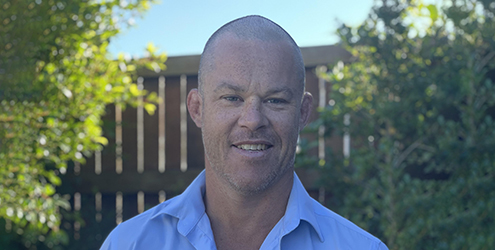Global
Copyright@ Australian Catholic University 1998-2025 | ABN 15 050 192 660 CRICOS registered provider: 00004G | PRV12008
Copyright@ Australian Catholic University 1998-2025 | ABN 15 050 192 660 CRICOS registered provider: 00004G | PRV12008

The past decade has been an era of rapid transformation in professional sport, with wearables and other observational technologies shifting the game not only for athletes and coaching staff, but also for the fans who cheer them on.
It all started in the early 2000s, when the most innovative minds in sports science began to realise the potential of microtechnology to maximise player performance.
At the time, Grant Duthie was pursuing a joint PhD at the University of Queensland and the Australian Institute of Sport, working alongside experienced physiologists like Professor Allan Hahn, leader of the now-defunct Cooperative Research Centre for Microtechnology.
“It was a period where microtechnology was starting to be developed and used in other industries, and these leaders in sports science thought, ‘Oh heck, can we use this with sport?’” says Dr Duthie, a senior lecturer and researcher with ACU’s Sports Performance, Recovery, Injury and New Technologies (SPRINT) Research Centre.
This group of Australian researchers was at the cutting edge of sports technology. One of their goals was to transfer traditional laboratory-based measurements to devices that could be worn, giving coaches and performance staff access to real-time data while their players trained and competed.
“Back then, whenever you wanted to assess athletes, you generally had to take them into a lab to do some kind of structured testing, but with this new technology, we could assess athletes in action,” says Dr Duthie, who upon completing his doctorate in 2004 was able to utilise these new technologies in his work with elite sporting teams.
Seemingly overnight, sports scientists had the ability to analyse previously unquantifiable aspects of player performance in fine detail.
“We were using GPS (global positioning system) units to track athletes, while also embedding other forms of microtechnology like inertial measurement units, which include accelerometers, magnetometers and gyros,” he says.
“As these technologies continued to develop, I went into professional sport and started using them in my roles as a high-performance manager within rugby league and rugby union, and had quite a bit of success with them.”
Elite clubs in rugby league and Australian rules football were among the earliest adopters of wearable tech, embracing the use of these devices when other sporting codes were still ambivalent about their potential.
These days, performance staff in a wide array of sports use GPS units, smart cameras, artificial intelligence (AI) and a range of other devices and technologies to monitor player activity.
This saturation of data is a boon for sports scientists and coaches. It gives them a clear window into the performance of the athletes they’re managing – from their average speed and the distance they’ve covered during a game or a training session, to other measures like acceleration and deceleration, which help to inform the intensity at which players should be performing.
But amid all this positive potential, Dr Duthie cautions that there is such a thing as too much data.
“I think one of the biggest challenges with all the GPS information we’re getting is that coaches can become a bit overwhelmed with the sheer volume of data and the number of metrics we can look at,” he says in a Vice Sports documentary on microtechnology, released in 2016.
In more recent times, both the producers of the technology and the sports scientists using it have begun to focus on meaningful data that is more easily analysed and interpreted.
“What probably happened initially was that the manufacturers of the technology had all the data, and their platforms would process that data,” says Dr Duthie, who joined ACU’s School of Behavioural and Health Sciences in 2017 after a 15-year career in elite sport.
“Nowadays, the sports scientist’s role has changed substantially, and they really need the skill set where they can manage the data themselves. They need to be able to code and process large volumes of information and do their own reports, and this level of data analysis has almost become an industry requirement.”
It is worth noting that there’s big money in sports technology. The industry is believed to be worth around $18 billion globally and is expected to reach $40 billion by 2026.
To benefit sporting teams, however, the data collected from these products needs to be both accurate and reliable.

Dr Grant Duthie
When companies first started to invest in wearable tech, devices were hitting the market at breakneck speed – and not all of them fit the bill.
“When there’s that much money involved, there’s always going to be new tech, and the flow-on effect is that some of that tech gets adopted en masse,” says Associate Professor David Opar, director of the SPRINT Research Centre.
“Under these circumstances, some of the basic questions we need to ask from a research perspective are: What is the validity and reliability of these devices? Do they actually measure what they propose to be measuring, and how reliable are those measures? How repeatable are they over time?
“It’s amazing how few people consider these questions when adopting technology. It’s not the sexiest stuff to consider, but if the device doesn’t measure what it says it’s measuring, you’ve got a bit of a problem.”
One of SPRINT’s great strengths, says Associate Professor Opar, is that it boasts some of the world’s leading experts in the validity and reliability of sports technology, whether the devices are measuring speed, analysing injury or providing data on advanced biomechanics.
Thankfully, the validation work that has occurred in the past decade has seen companies refine and improve their products, causing the uptake from the sporting community to explode.
“Certain the accuracy of the different technologies has improved dramatically, and that’s what a lot of our research has been focused on,” says Dr Duthie, who consults to several sporting organisations to assist in the validation, analysis, management and visualisation of data.
For the past five years, he has been driving the data analysis on a collaboration with FIFA (Federation Internationale de Football Association) and Victoria University. His main role in the project is to help football’s world governing body to improve the accuracy of the information that managers use to make critical decisions around match tactics and player replacements.
Once again, Dr Duthie stresses the point that in such a high-stakes setting, accuracy and reliability is paramount.
“Obviously there’s a lot of money being spent, and this is an elite and high-level competition, so it’s vital to have faith in the gear,” he says.
Then there’s the broadcasting application of the data, which could dramatically change the experience of sport for fans and screen audiences.
“In the upcoming World Cup, you’ll be able to get online, bring up a player and say, ‘I want to view every time they receive the ball’, and you’ll have access to all their tracking information – speed, distance covered, etcetera,” Dr Duthie says, pointing out that simpler versions of this technology are already in use in rugby league, basketball and many other team sports.
“It’s a much more interactive experience, with an online platform where the viewer has access to a whole lot of information that was previously not publicly available.”
So, with new technologies continuing to emerge that redefine the way that sport is played, coached and viewed, what is the future?
According to Dr Duthie, the big shift will be in AI-driven camera systems rather than wearables.
“It’s a technology that is developing very rapidly and becoming a lot simpler to use, and it’s truly mind-blowing to think what AI will do two decades from now,” he says.
“Beyond that, it’ll be the merging of wearables and camera-based systems, because they both have their own benefits, and when we’re able to combine the two in a way that’s simple and effective, that will be a huge advance in the player tracking technology space.”
And what about coaching nous? Will technological advancements signal the death of gut instinct, the end of the coach’s hunch? Not so, say the experts.
“Even in this day and age, I think gut instinct and a coach’s eye is one of the best ways to evaluate a situation and make decisions on the spot, because a good coach knows their sport and knows their players,” says Dr Duthie, underscoring his view that “the art of coaching” will play just as big a role as it always has, with “the science of coaching” supplementary.
“We’ve got all this data to evaluate and analyse, and coaches have always wanted that information, but it’s not some kind of magic tool that changes things in some dramatic way. Some things in sport are unquantifiable, and I truly believe that knowing how to prepare athletes and prepare a team is still the biggest factor, and it always will be.”
Find out more about the SPRINT Research Centre’s projects and programs.
Keen to pursue a career in elite sport and gain access to some of the world’s leading researchers and practitioners? Check out ACU’s Master of High Performance Sport.
Copyright@ Australian Catholic University 1998-2025 | ABN 15 050 192 660 CRICOS registered provider: 00004G | PRV12008